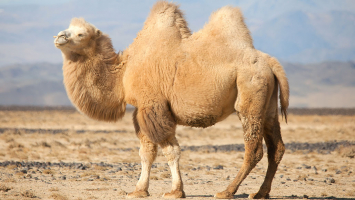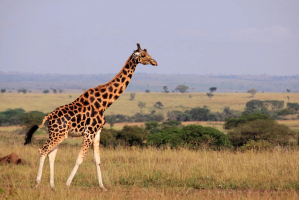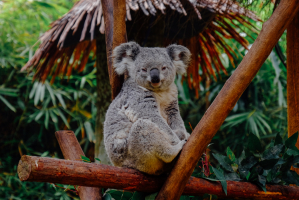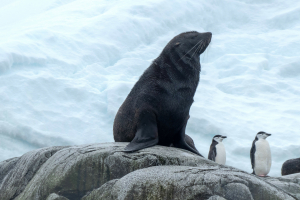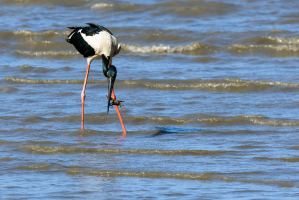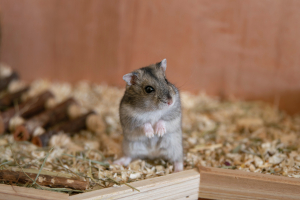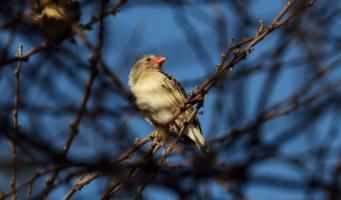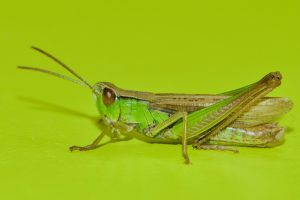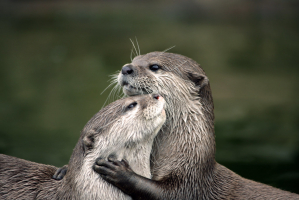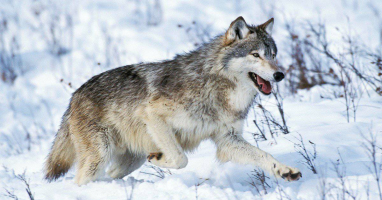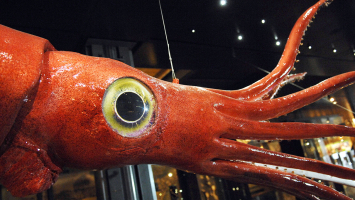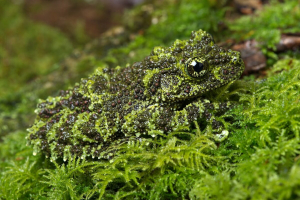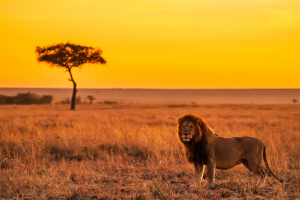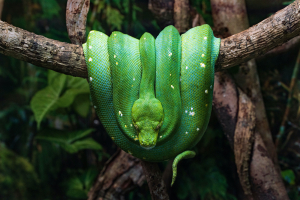Top 10 Wonderful Animals That Start With 'W'
Discover a world of wonder with animals that start with 'w.' These wondrous creatures, from the water to the wild, offer a glimpse into the diversity of ... read more...nature. This article explores the unique characteristics and fascinating facts of the top 10 animals that start with 'w.'
-
Do you know what a walrus is? It's a large, fascinating creature living near the Arctic Circle. Imagine a big, bulky animal with long, white tusks and a mustache of whiskers! That's a walrus for you, a marine mammal that loves the company of its friends.
Walruses are huge and spend lots of time lying on the ice. Their home is the chilly Arctic, where they gather in large groups. Despite their size, they are friendly and love to chat with loud bellows and snorts. But watch out! When it's time to find a mate, they can get pretty tough.
Walruses have a special feature that makes them stand out – their long tusks. These aren't just for looks; they use them to pull themselves out of the water and to make holes in the ice so they can breathe. Both male and female walruses have these tusks, which keep growing their whole lives!
Their tusks can be as long as three feet. Can you imagine that? It's like as tall as a small child! And their whiskers are super sensitive. It helps them find their favorite food on the dark ocean floor. They love eating shellfish, which they find by feeling around with their whiskers.
The whiskers of a walrus are also special. They are super sensitive. They help the walrus find its favorite food, shellfish, on the dark ocean floor. The walrus feels around with its whiskers until it finds something tasty to eat.
Walruses are perfectly built for living in the cold. They have a thick layer of fat called blubber, which keeps them warm in freezing temperatures. They are so good at surviving in the cold that they can even slow down their heartbeat to stay warm in icy waters. Males are really big, weighing up to 1.5 tons – that's as heavy as a small car!
There are two types of walruses, the Atlantic and the Pacific. They live in different parts of the Arctic and move around with the seasons. When it's time, mother walruses give birth during these long trips. Welcoming new baby walruses into the world.
Walruses were in danger in the past because people hunted them too much. Their tusks, oil, and skin were in high demand. Now, there are rules to protect them. Only certain people are allowed to hunt them. This helps keep the walruses safe. We want these amazing creatures to live for a very long time.
Key Takeaways:
- Type: Walruses are friendly marine mammals.
- Size: They can grow up to 11.5 feet long.
- Weight: Some can weigh as much as 1.5 tons.
- Diet: They mainly eat shellfish.
- Average Lifespan: They can live up to 40 years in the wild.
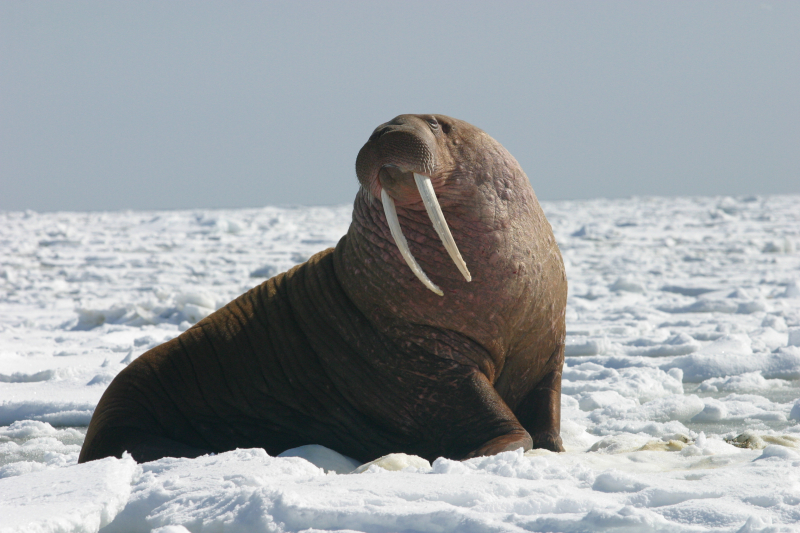
Screenshot of https://en.wikipedia.org/wiki/Walrus Video by Learn about Animals -
Have you ever heard of a wolf spider? They're a family of large, hairy spiders that are very athletic. Unlike many spiders, they don't catch their prey in webs. Instead, they chase it down, just like a wolf. But they hunt alone, not in packs.
Wolf spiders are found all around the world, with nearly 2,400 species across 125 genera. You can find them in the U.S. too. They live in many places, from grasslands and meadows to mountains and rainforests. They go wherever they can find insects to eat.
Wolf spiders have a unique look. They are usually brown, gray, black, or tan with dark markings. These colors help them blend into their surroundings. This camouflage helps them sneak up on their prey and stay hidden from predators. Wolf spiders vary in size. Some are as small as a quarter of an inch, while others can be over an inch long. The Desertas wolf spider is one of the largest and has a leg span of 4.7 inches!
These spiders have a distinctive eye arrangement. Their front row has four small eyes arranged in almost a straight line. The back row is arranged in a V-pattern. Wolf spiders have excellent night vision and mainly hunt in the dark. You can spot them at night because their eyes shine brightly.
Are wolf spiders dangerous? They can bite if they feel threatened, but their venom isn't very harmful to humans. Bites might cause redness or swelling but no serious problems. Still, their bites can be very painful, so it's best not to pick them up.
Wolf spiders are mostly active at night. They prefer to live on the ground but can climb if they need to. Their homes include areas with low vegetation and gravel. Sometimes, they wander into houses, especially in basements or crawl spaces.
Wolf spiders eat ground-dwelling insects like crickets and other spiders. Sometimes, large females will even eat small amphibians and reptiles. They might chase down their prey or wait and ambush it. When they catch something, they jump on it, hold it with their legs, and roll over to trap it before biting and injecting venom.
These spiders are good at avoiding predators. They use their keen eyesight, camouflage, and sensitivity to vibrations to stay safe. Some animals, like lizards, birds, and hunting wasps, prey on them. Hunting wasps sting and paralyze wolf spiders, drag them to their burrows and lay eggs on them. When the eggs hatch, the larvae have food.
Wolf spiders have an interesting mating ritual. The males wave their legs and pedipalps to signal to the females. After mating, females lay dozens of eggs and wrap them in silk to create an egg sac. They carry this sac around with them. Mothers are very protective of their egg sacs and will search for them if lost. Some studies show that they can even recognize their egg sacs.
After the spiderlings hatch, they climb onto their mother's back. She carries them around for several days. Then, they leave to start their lives alone. Male wolf spiders usually live for about a year, while females can live for several years.
Key Takeaways:
- Type: Wolf spiders are large, hairy, and athletic spiders.
- Size: 0.4 to 1.38 inch
- Weight: Varies widely depending on the species.
- Diet: They mainly eat ground-dwelling insects.
- Average Lifespan: Males live about a year, while females can live several years.
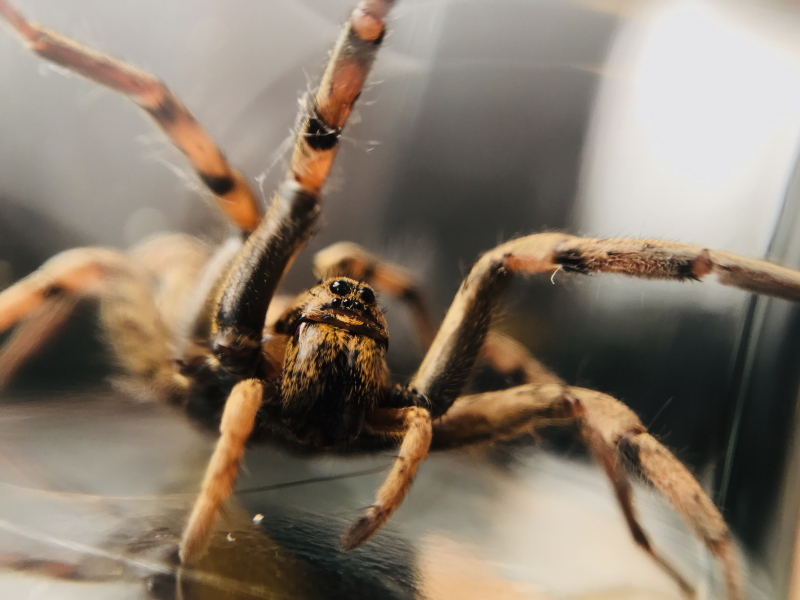
Screenshot of https://en.wikipedia.org/wiki/Wolf_spider Video by MyWildBackyard -
Warthogs might not be the first animal you think of on an African safari, but they are one of the most interesting. Their scientific name is Phacochoerus Africanus, but most people know them as the common warthog. They get their name from the wart-like bumps on their faces. These aren't real warts, though. They're made of bone and cartilage and help protect warthogs when they fight.
One fun fact about warthogs is how they sleep. At night, they rest in burrows underground. But they don't dig these themselves. Instead, they take over burrows left by other animals like aardvarks. This shows how smart they are at using what's around them to survive.
Warthogs are mostly grass eaters. But when it's dry and the grass is hard to find, they dig for roots and bulbs. They are not picky eaters and will eat meat if they get the chance. They are omnivores, which means they eat both plants and animals.
Do you know why warthogs like to roll in the mud? It's not just for fun. The mud helps protect their skin from the hot sun and bothersome bugs. This is a clever way to stay cool and bug-free.
Warthogs usually have two to four piglets at a time. But life is tough for these little ones. Many don't make it because of predators. To keep them safe, mother warthogs let their babies go into their burrows first. Then they back in themselves. This way, they can run out quickly to protect their young if danger comes.
The tusks of a warthog are another interesting feature. They look a bit like elephant tusks and are found on both their upper and lower jaws. Warthogs use these tusks to fight and defend themselves. They even use their snouts and tusks to lift the soil when searching for food. When eating, they often bend down onto their wrists. This is unusual and helps them reach the ground more easily.
Warthogs can live surprisingly long lives, up to 17 years in the wild. This is quite old for an animal that faces so many dangers every day.
Key Takeaways:
- Type: Warthogs are tough, smart animals that live in Africa.
- Size: Three to five feet.
- Weight: Adult warthogs can weigh between 125 and 300 pounds.
- Diet: They mainly eat grass, roots, and bulbs, but will eat meat if available.
- Average Lifespan: They can live up to 17 years in the wild.
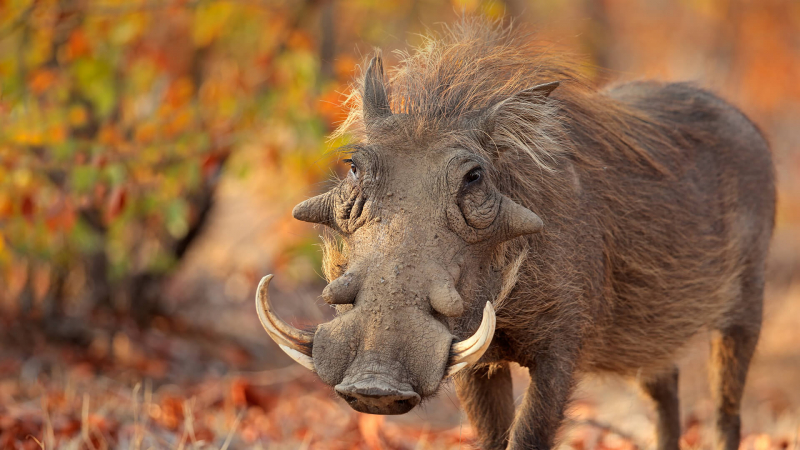
Screenshot of https://animals.sandiegozoo.org/animals/warthog Video by Nat Geo WILD -
Weasel sharks, specifically the Atlantic Weasel Shark species, are a fascinating part of the ground shark family. They have a unique set of features that make them stand out in the underwater world. With their moderately long snouts and large eyes equipped with nictitating membranes, these sharks are well-adapted predators. The membranes protect their eyes, an essential adaptation for their hunting lifestyle.
Their appearance is striking, with light grey or bronze skin accented by vertical yellow stripes along their slender bodies. This coloring can make them both beautiful and formidable. They have two dorsal fins, with the first being larger and located in front of the pelvic fins. Their pectoral fins are long and pointed, aiding in their agile swimming. While the smaller anal fin is less prominent than the second dorsal fin. The asymmetrical caudal fins add to their efficient movement through water.
In terms of size, a fully-grown Atlantic weasel shark typically measures around 140 cm. Although most are commonly found to be about 100 cm long. The growth of these sharks is an interesting aspect of their biology. Females reach sexual maturity when they're between 75 cm to 90 cm and males around 80 cm. This suggests a fairly quick growth rate to adulthood.
Atlantic weasel sharks dive to depths of up to 100 meters. However, they are predominantly found in shallower waters ranging from 30 m to 70 m. This preference for shallower depths might be related to their diet, which mainly consists of cephalopods and small bony fish. Their hunting skills and diet are vital parts of their role in the ocean ecosystem.
Reproduction in these sharks is viviparous, meaning the females give birth to live young. They can give birth to one to four pups at a time, with each newborn measuring about 47 cm. This reproductive strategy is fascinating and differs significantly from many other fish species that lay eggs.
However, the Atlantic weasel shark faces threats from human activities. They are vulnerable to fishing pressure within their range and are often caught by various means such as longlines, hook and line, gillnets, and bottom trawls. This has raised concerns about their conservation status. The International Union for Conservation of Nature (IUCN) has listed them as data deficient. It indicates that more information is needed to fully understand their population and the threats they face.
Key Takeaways:
- Type: Atlantic Weasel Sharks are a species of ground shark.
- Size: Adults typically measure around 140 cm, but most are commonly around 100 cm.
- Weight: 24 pounds
- Diet: They primarily feed on cephalopods and small bony fish.
- Average Lifespan: About 2 years old
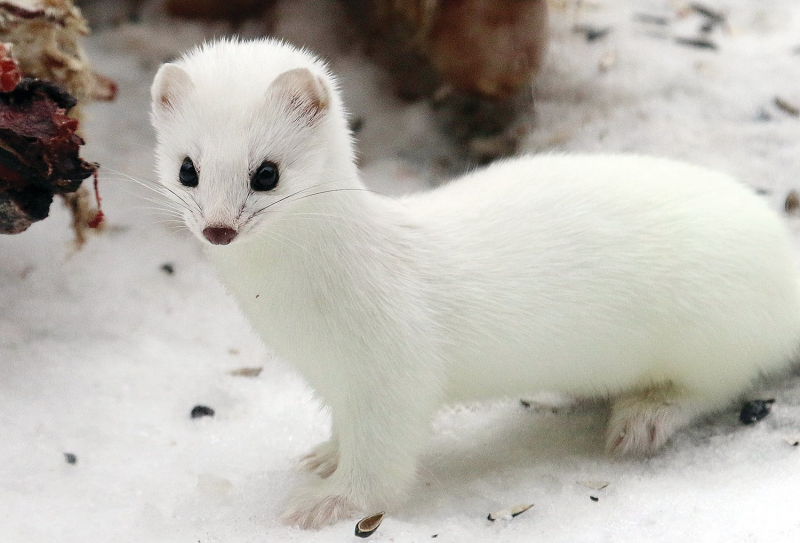
Screenshot of http://www.timberjay.com/stories/weasels-winter-white,17269 Video by PBS -
Whales are the giants of the ocean, roaming all the world's seas. Their size is staggering. For instance, the blue whale, the largest animal on Earth, can grow over 100 feet long and weigh as much as 200 tons. That's about as heavy as 33 elephants! But despite their enormous size, whales are graceful swimmers. They glide through the water with ease, thanks to their streamlined bodies.
These magnificent creatures are not fish but mammals, just like us. They breathe air through a blowhole on top of their heads and are warm-blooded. This means they can maintain a constant body temperature, no matter how cold the water gets. They have a thick layer of fat called blubber. This blubber keeps them warm in chilly ocean waters.
There are two main types of whales: baleen whales and toothed whales. Baleen whales include species like the blue, right, bowhead, sei, and gray whales. They don't have teeth. Instead, they have baleen plates in their mouths. These plates act like a sieve. The whales take in a huge gulp of water and then push it out through the baleen, trapping their food inside. This food is mostly tiny creatures like krill and small fish.
Toothed whales, like the beluga and sperm whales, do have teeth. They use these teeth to grab and eat larger prey. This can include fish, squid, and sometimes other marine mammals. Toothed whales are often more active hunters than their baleen relatives.
Whales are known for their complex and mysterious songs, especially the humpback whales. These songs can travel great distances underwater. Scientists believe whales use these sounds to communicate with each other. They might share information about food, dangers, or looking for a mate.
Despite their power and size, whales face many threats. These include pollution, ship strikes, and getting caught in fishing gear. Conservation efforts are in place to protect these majestic creatures. Their survival is crucial for the health of the ocean.
Key Takeaways:
- Type: Whales are warm-blooded mammals, not fish, and breathe air.
- Size: The blue whale, the largest species, can exceed 100 feet in length.
- Weight: Blue whales can weigh up to 200 tons, about as much as 33 elephants.
- Diet: Baleen whales feed on small fish and krill, while toothed whales eat larger prey.
- Average Lifespan: Varies by species, but many live 50-100 years, with some even longer.
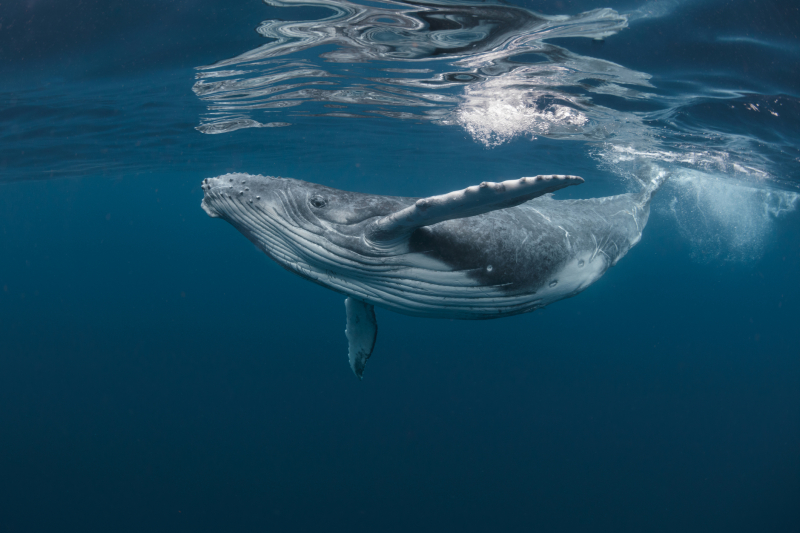
Screenshot of https://www.discoverwildlife.com/animal-facts/marine-animals/humpback-whale-facts Video by Nat Geo WILD -
Wolffish are unique sea creatures found in the cold waters of the northern Atlantic and Pacific oceans. These fish are part of the family Anarhichadidae and are known for their distinctive appearance and robust nature. They can grow quite large, with some species reaching up to 2.3 meters (about 7.5 feet) in length. Imagine a fish longer than a tall person!
One of the most striking features of the wolffish is its teeth. They have large canines and heavy molars, making their teeth formidable. These serve a critical purpose. Wolffish use these powerful teeth to eat hard-shelled creatures like crabs, starfish, and sea urchins. Their diet is quite different from many other fish.
Wolffish can be found in a range of ocean depths, from the shoreline down to depths of 300 meters or more. This adaptability allows them to thrive in various environments, from shallow waters to the deep sea. Despite their fierce appearance, wolffish play a significant role in their ecosystem. It helps to control the populations of the creatures they feed on.
In Europe, wolffish are sometimes referred to as catfishes. Although they are not related to the freshwater catfish found in other parts of the world. They are appreciated not only for their unique place in the ocean's food web but also as a food source for humans. Both in Europe and the United States, wolffish are caught and consumed, valued for their meat.
Several species of wolffish exist, including the Atlantic wolffish (Anarhichas lupus), known for its vertical bands, and the spotted wolffish or spotted catfish (A. minor), which is found in the North Atlantic. Another relative, the wolf-eel (Anarhichthys ocellatus), is a black-spotted species living in the eastern Pacific.
Key Takeaways:
- Type: Wolffish are large, long-bodied marine fish.
- Size: They can grow up to about 2.3 meters (7.5 feet) in length.
- Weight: Specific weights vary, but they are robust, heavy fish.
- Diet: Their diet mainly consists of hard-shelled creatures like crabs, starfish, and sea urchins.
- Average Lifespan: The lifespan varies by species but is generally around 9-20 years.
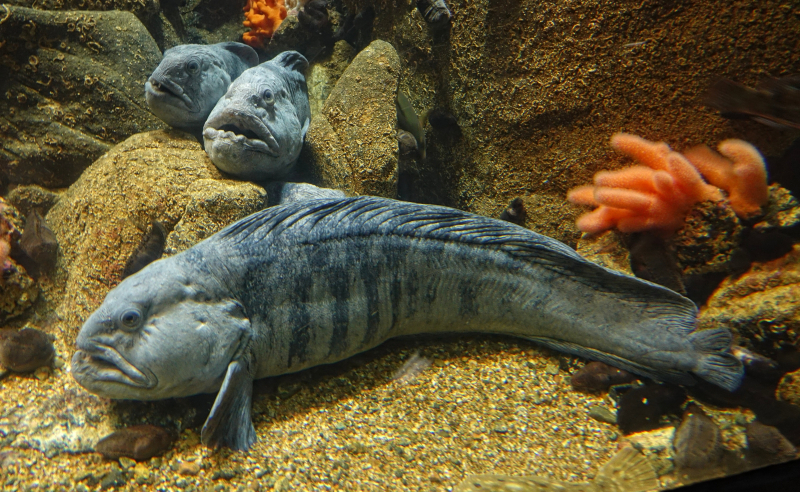
Screenshot of https://en.wikipedia.org/wiki/Atlantic_wolffish Video by BlueWorldTV -
The white rhino is an iconic species of the African savannah. It is known for its imposing size and distinctive features. As one of the largest land mammals, the white rhino, particularly the Northern white rhino, has become a symbol for conservation efforts due to its critically endangered status. These gentle giants have unique attributes and face challenges that set them apart from other wildlife.
White rhinos are characterized by their square-lipped mouth, which is an adaptation for grazing. Unlike their black rhino cousins, which are browsers, white rhinos have a broad, flat mouth for eating grass. They spend much of their time in savannahs and grassy plains, where they graze peacefully. A mature white rhino can weigh up to 2,300 kg and reach lengths of up to 4 meters. They are massive, with a large head and a hump on their neck, which supports their large skull.
One of the most striking features of white rhinos is their two horns, with the front horn being longer. These horns are made of keratin, the same substance that forms human hair and nails. Unfortunately, these horns are highly coveted. That leads to rampant poaching that has significantly threatened their populations.
White rhinos have a relatively long lifespan, living up to 40-50 years in the wild. They have few natural predators, thanks to their size and the protective social groups they form. These groups, called crashes, usually consist of females and their offspring. Males are typically solitary but can be territorial.
Their diet is strictly herbivorous, consisting mainly of grass. They have a wide mouth adapted for grazing on the grasslands of Africa. They need to consume a significant amount of grass each day to sustain their large bodies. Which contributes to their role in shaping and maintaining the African grassland habitat.
Despite their size and strength, white rhinos face significant threats from humans. Poaching for their horns is the most significant threat. This has led to drastic declines in their population. Conservation efforts are ongoing to protect these magnificent creatures, with strategies focusing on anti-poaching measures and maintaining their natural habitats.
Key Takeaways:
- Type: White rhinos are large, grass-grazing mammals.
- Size: They can reach up to 4 meters in length.
- Weight: Adults can weigh up to 2,300 kg.
- Diet: They are herbivores, primarily feeding on grass.
- Average Lifespan: They can live for 40-50 years in the wild.
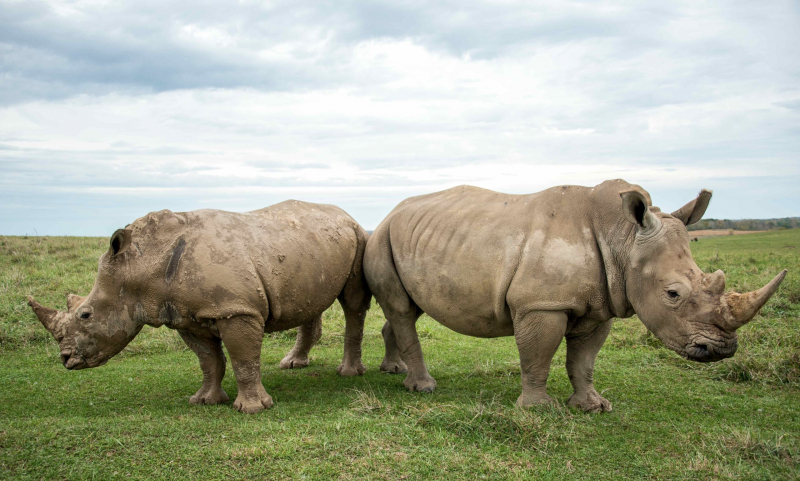
Screenshot of https://rhinos.org/about-rhinos/rhino-species/white-rhino/ Video by BBC Earth -
The wildebeest, also known as the gnu, is a captivating member of the antelope family. It boasts a large, box-like head and curving horns. Its body is a study in contrasts. The front end is heavily built, while the hindquarters are slender with spindly legs. Their coat is a distinctive gray, complemented by a black mane and beard. The beard can be black or white.
Several races of wildebeest roam the African plains. The western white-bearded wildebeest forms vast herds in the Serengeti-Mara ecosystem. Meanwhile, the eastern white-bearded race inhabits areas east of the Gregory Rift. The brindled or blue race is known for its darker color and lives south of the Zambezi River.
An adult wildebeest can weigh between 260 to 595 pounds. They stand up to 48 inches long. Despite their bulk, they are surprisingly agile. They are built for endurance, perfect for life on the open plains. In the wild, they can live up to 20 years. They thrive in open woodlands and grassy plains, constantly on the move.
As herbivores, wildebeests are always in search of fresh grass and water. Their diet drives their famous migratory behavior. The Serengeti population undertakes an annual migration of 500 to 1,000 miles each year. The journey starts after the calving season. It's a relentless pursuit of sustenance. During this time, many are injured, lost, or killed. By the end of the dry season, they return to the Serengeti plains as the rains begin.
Habitat fragmentation poses a significant threat to wildebeests. As land is fenced off for agriculture, their paths are disrupted. Along with water source reduction and poaching, their survival hangs in the balance. Organizations are addressing this by engaging with governments and communities. They propose solutions to habitat fragmentation and provide sustainable agricultural tools. These efforts aim for a balance between modernization and conservation.
Wildebeests are social and vocal creatures. Bulls are particularly loud with a range of sounds. An interesting aspect of their life is their calving behavior. About 80 percent of females calve within the same two- to three-week period. This strategy overwhelms predators and allows more calves to survive.
Key Takeaways:
- Type: Wildebeests are robust members of the antelope family.
- Size: They can grow up to 48 inches in length.
- Weight: Adults weigh between 260 to 595 pounds.
- Diet: They are herbivores, constantly searching for grass and water.
- Average Lifespan: They can live for up to 20 years in the wild.
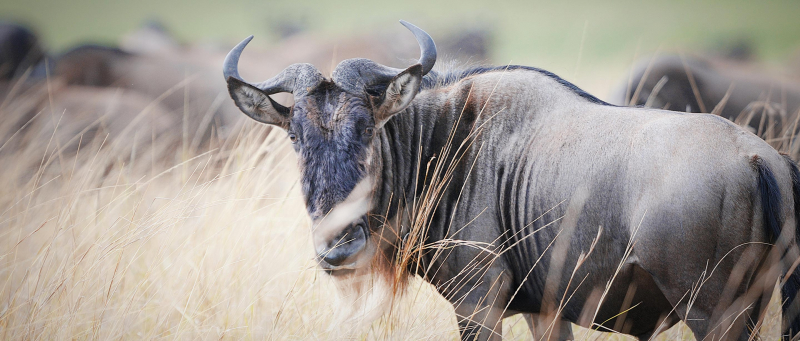
Screenshot of https://www.awf.org/wildlife-conservation/wildebeest Video by National Geographic -
Wombats are one of Australia's most beloved marsupials, known for their quirky traits and adorable appearance. They belong to a family of marsupials that includes the koala, their closest living relative. Despite their cuddly looks, wombats are robust and have several unique characteristics that set them apart in the animal kingdom.
One of the most fascinating aspects of wombats is their cubic poop. Yes, you read that right! Wombats excrete cube-shaped feces. This peculiar shape prevents their droppings from rolling away, marking their territory on rocks and logs effectively. It's one of nature's more unusual designs and certainly a conversation starter.
Wombats have a rather unusual defense mechanism: their behind. When threatened, they dive into their burrows and use their tough rear to block the entrance. Their backside, primarily composed of cartilage, is resistant to scratches and bites. Incredibly, they can even crush the skulls of predators with their powerful rear ends.
There are three subspecies of wombat: the Bare-Nosed Wombat (Vombatus Ursinus), Southern Hairy-nosed (Lasiorhinus latifrons), and Northern Hairy Nosed (Lasiorhinus krefftii). Each has its own distinct characteristics and habitat preferences. These creatures are social, often forming groups known as a wisdom.
Wombats are hefty creatures, with the heaviest recorded wombat weighing 38kg, about the weight of four koalas combined. Despite their bulky build, they are surprisingly fast, capable of running at speeds of 40 km/h. This speed is just a bit slower than the fastest humans!
Another distinctive feature of wombats is their ever-growing teeth. Like rodents, their teeth continue to grow throughout their lives. This adaptation is crucial as it compensates for the wear and tear from munching on grasses, roots, shrubs, and vegetables. Their digestive system is equally remarkable. Wombats have a slow metabolism, and their guts can hold food for up to 70 hours, taking four to six days to digest a meal fully.
Wombats are the second largest of all marsupials, following the Red Kangaroo. The largest ever marsupial was the Diprotodon, a wombat-like creature standing around 2 meters tall.
Key Takeaways:
- Type: Wombats are robust, burrowing marsupials from Australia.
- Size: They are one of the largest marsupials.
- Weight: The heaviest recorded was 38kg.
- Diet: They feed on grasses, roots, shrubs, and vegetables.
- Average Lifespan: They can live up to 15 years in the wild.
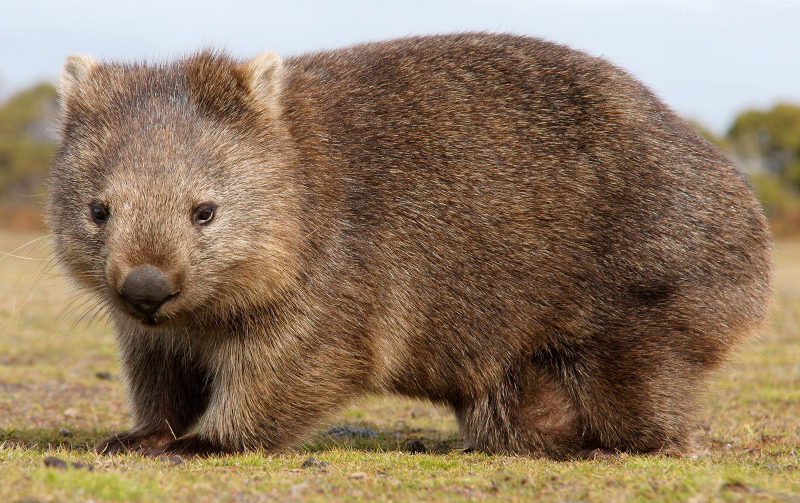
Screenshot of https://www.britannica.com/animal/wombat Video by Animalogic -
The wahoo, also known as the Pacific kingfish, is a striking and sought-after sport fish. It's known for its dark blue-green back, largemouth, and razor-sharp teeth. An adult wahoo can weigh between 79 to 84 kg and reach lengths of up to 8 feet. These fish are incredibly fast, and capable of swimming at a rate of 60 mph. Such speed makes them one of the fastest fish in the sea and a prized catch for offshore anglers.
Wahoo, scientifically known as Acanthocybium solandri, belongs to the family Scombridae, the same family as mackerels. They are an exclamation due to their extraordinary speed. Their flesh is highly valued, making them one of the top game fish in the world.
The body of the wahoo is distinct and beautiful. Their back is dark blue-green with small, visible silver scales on the upper side. Light blue stripes mark their flanks and sides. Their large mouths house razor-sharp teeth. It is essential for their carnivorous diet. The forked, blade-like tail is a characteristic feature of their family and contributes to their incredible speed.
Wahoo fish are distinguishable from similar species. Their teeth are shorter and more closely packed compared to King mackerel. Unlike barracudas, wahoos have small mackerel scales and a fork-like tail. The barracuda's dagger-like teeth and lack of keels also set them apart from the wahoo.
Wahoos prefer epipelagic ecosystems, the sea zone close to the surface where light continues to penetrate. They are commonly found up to 1,000 feet beneath the surface in open sea and near the shore. They thrive in tropical and subtropical seas worldwide, from the Pacific, Atlantic, and Indian oceans to the Mediterranean and Ionian seas.
Their diet is primarily carnivorous. It consists of squid, halfbeak, gurnard, flying fish, cephalopods, and crustaceans. They are formidable predators, actively swimming in pursuit of their prey. The best time for wahoo fishing is from September through April, especially during full-moon and new-moon phases when they are actively feeding. Cooler water and color-changing zones are good spots to find them.
Effective wahoo fishing requires high-power reels, as they are fast and powerful fish. Two-speed line reels with wire leaders are recommended due to the wahoo's sharp teeth. For baits, speedos and Goggle-eyes are effective. Lures that produce live swimming actions and vibrant colors can also be game-changers.
Trolling is a popular and effective method for catching wahoo. High-speed trolling, in particular, can be very successful. Other methods include kite fishing and chunking. Casting can also be an option. Look for signs of feeding frenzies and diving birds. Fast gear and an active angler are necessary for this method.
Key Takeaways:
- Type: Fast, predatory sport fish.
- Size: They can reach lengths of up to 8 feet.
- Weight: Adults typically weigh between 79 to 84 kg.
- Diet: They feed on squid, flying fish, and other sea creatures.
- Average Lifespan: Up to 5 or 6 years
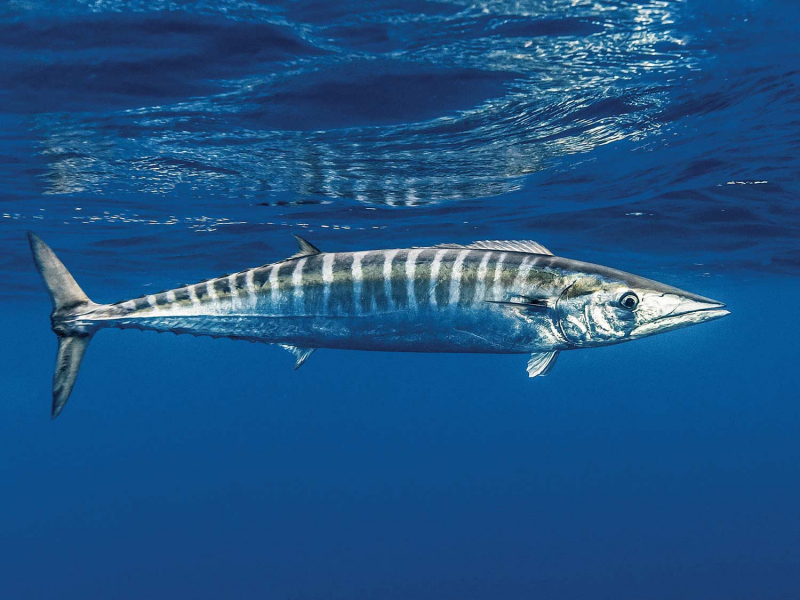
Screenshot of https://www.marlinmag.com/story/howto/how-to-catch-wahoo-in-the-winter-bahamas/ 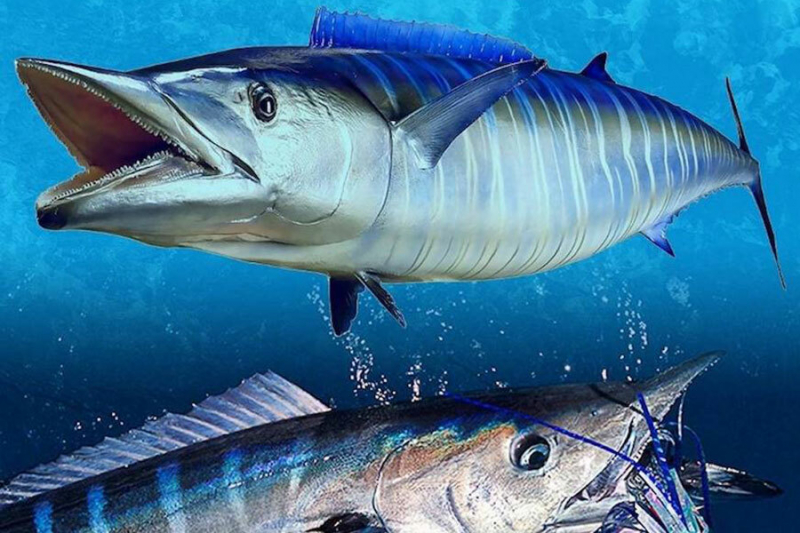
Screenshot of https://inthespread.com/blog/wahoo-fish-the-valued-game-fish-and-best-sports-fish-221












